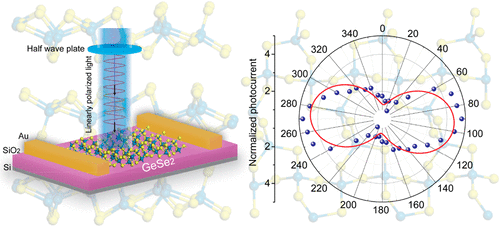当前位置:
X-MOL 学术
›
J. Am. Chem. Soc.
›
论文详情
Our official English website, www.x-mol.net, welcomes your
feedback! (Note: you will need to create a separate account there.)
Air-Stable In-Plane Anisotropic GeSe2 for Highly Polarization-Sensitive Photodetection in Short Wave Region
Journal of the American Chemical Society ( IF 14.4 ) Pub Date : 2018-03-01 , DOI: 10.1021/jacs.8b01234 Yusi Yang 1, 2 , Shun-Chang Liu 1, 3 , Wei Yang 2 , Zongbao Li 4 , Yang Wang 5 , Xia Wang 4 , Shishu Zhang 2 , Yun Zhang 1 , Mingsheng Long 5 , Gengmin Zhang 2 , Ding-Jiang Xue 1, 3 , Jin-Song Hu 1, 3 , Li-Jun Wan 1, 3
Journal of the American Chemical Society ( IF 14.4 ) Pub Date : 2018-03-01 , DOI: 10.1021/jacs.8b01234 Yusi Yang 1, 2 , Shun-Chang Liu 1, 3 , Wei Yang 2 , Zongbao Li 4 , Yang Wang 5 , Xia Wang 4 , Shishu Zhang 2 , Yun Zhang 1 , Mingsheng Long 5 , Gengmin Zhang 2 , Ding-Jiang Xue 1, 3 , Jin-Song Hu 1, 3 , Li-Jun Wan 1, 3
Affiliation

|
In-plane anisotropic layered materials such as black phosphorus (BP) have emerged as an important class of two-dimensional (2D) materials that bring a new dimension to the properties of 2D materials, hence providing a wide range of opportunities for developing conceptually new device applications. However, all of recently reported anisotropic 2D materials are relatively narrow-bandgap semiconductors (<2 eV), and there has been no report about this type of materials with wide bandgap, restricting the relevant applications such as polarization-sensitive photodetection in short wave region. Here we present a new member of the family, germanium diselenide (GeSe2) with a wide bandgap of 2.74 eV, and systematically investigate the in-plane anisotropic structural, vibrational, electrical, and optical properties from theory to experiment. Photodetectors based on GeSe2 exhibit a highly polarization-sensitive photoresponse in short wave region due to the optical absorption anisotropy induced by in-plane anisotropy in crystal structure. Furthermore, exfoliated GeSe2 flakes show an outstanding stability in ambient air which originates from the high activation energy of oxygen chemisorption on GeSe2 (2.12 eV) through our theoretical calculations, about three times higher than that of BP (0.71 eV). Such unique in-plane anisotropy and wide bandgap, together with high air stability, make GeSe2 a promising candidate for future 2D optoelectronic applications in short wave region.
中文翻译:

空气稳定的面内各向异性 GeSe2 用于短波区域的高偏振敏感光电检测
黑磷 (BP) 等面内各向异性层状材料已成为一类重要的二维 (2D) 材料,为二维材料的特性带来了新的维度,因此为开发新概念提供了广泛的机会。设备应用程序。然而,最近报道的各向异性二维材料都是相对窄带隙的半导体(<2 eV),而这类材料的宽带隙尚未见报道,限制了相关应用,如短波区的偏振敏感光电检测. 在这里,我们展示了该家族的一个新成员,二硒化锗 (GeSe2),带隙为 2.74 eV,并系统地研究了从理论到实验的面内各向异性结构、振动、电学和光学特性。由于晶体结构的面内各向异性引起的光吸收各向异性,基于 GeSe2 的光电探测器在短波区域表现出高度偏振敏感的光响应。此外,剥离的 GeSe2 薄片在环境空气中表现出出色的稳定性,这源于我们的理论计算,GeSe2 上氧化学吸附的高活化能 (2.12 eV),大约是 BP (0.71 eV) 的三倍。这种独特的面内各向异性和宽带隙,以及高空气稳定性,使 GeSe2 成为未来短波区域二维光电应用的有希望的候选者。剥落的 GeSe2 薄片在环境空气中表现出出色的稳定性,这源于通过我们的理论计算,GeSe2 上氧化学吸附的高活化能 (2.12 eV),大约是 BP (0.71 eV) 的三倍。这种独特的面内各向异性和宽带隙,以及高空气稳定性,使 GeSe2 成为未来短波区域二维光电应用的有希望的候选者。剥落的 GeSe2 薄片在环境空气中表现出出色的稳定性,这源于通过我们的理论计算,GeSe2 上氧化学吸附的高活化能 (2.12 eV),大约是 BP (0.71 eV) 的三倍。这种独特的面内各向异性和宽带隙,以及高空气稳定性,使 GeSe2 成为未来短波区域二维光电应用的有希望的候选者。
更新日期:2018-03-01
中文翻译:

空气稳定的面内各向异性 GeSe2 用于短波区域的高偏振敏感光电检测
黑磷 (BP) 等面内各向异性层状材料已成为一类重要的二维 (2D) 材料,为二维材料的特性带来了新的维度,因此为开发新概念提供了广泛的机会。设备应用程序。然而,最近报道的各向异性二维材料都是相对窄带隙的半导体(<2 eV),而这类材料的宽带隙尚未见报道,限制了相关应用,如短波区的偏振敏感光电检测. 在这里,我们展示了该家族的一个新成员,二硒化锗 (GeSe2),带隙为 2.74 eV,并系统地研究了从理论到实验的面内各向异性结构、振动、电学和光学特性。由于晶体结构的面内各向异性引起的光吸收各向异性,基于 GeSe2 的光电探测器在短波区域表现出高度偏振敏感的光响应。此外,剥离的 GeSe2 薄片在环境空气中表现出出色的稳定性,这源于我们的理论计算,GeSe2 上氧化学吸附的高活化能 (2.12 eV),大约是 BP (0.71 eV) 的三倍。这种独特的面内各向异性和宽带隙,以及高空气稳定性,使 GeSe2 成为未来短波区域二维光电应用的有希望的候选者。剥落的 GeSe2 薄片在环境空气中表现出出色的稳定性,这源于通过我们的理论计算,GeSe2 上氧化学吸附的高活化能 (2.12 eV),大约是 BP (0.71 eV) 的三倍。这种独特的面内各向异性和宽带隙,以及高空气稳定性,使 GeSe2 成为未来短波区域二维光电应用的有希望的候选者。剥落的 GeSe2 薄片在环境空气中表现出出色的稳定性,这源于通过我们的理论计算,GeSe2 上氧化学吸附的高活化能 (2.12 eV),大约是 BP (0.71 eV) 的三倍。这种独特的面内各向异性和宽带隙,以及高空气稳定性,使 GeSe2 成为未来短波区域二维光电应用的有希望的候选者。











































 京公网安备 11010802027423号
京公网安备 11010802027423号